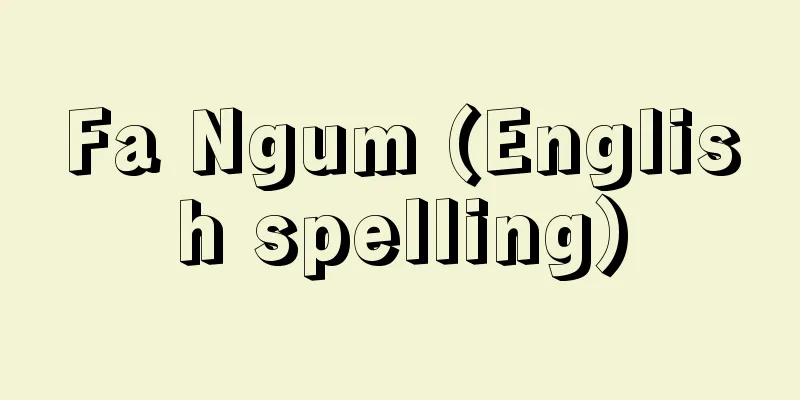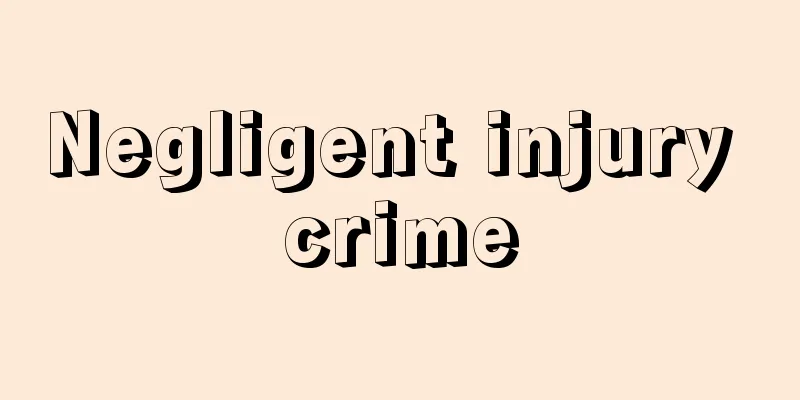Regeneration

|
This is the phenomenon in which, when a part of an organism's body is damaged for some reason, it repairs the lost part and enables it to continue living as an individual. However, when only a very small part of the body is repaired, such as a cut on the human skin, this is called wound healing or wound healing, and is often distinguished from regeneration, which refers to the repair of a large part of the body. In addition, the creation of a new organism from dissociated cells in sponges is called reconstruction, which is generally distinguished from regeneration. [Shigeo Takeuchi] Playback TypeRegeneration of damaged body parts due to physiological circumstances of the individual, such as the shedding of a deer's antlers, is called physiological regeneration. Other examples of this include bird molting and the replacement of human hair. In contrast, repair of damage caused by accidental causes is called traumatic regeneration (pathological regeneration). Traumatic regeneration can be further divided into morphological adjustment, in which repair of the shape of the damaged part is achieved by reorganization of only the surrounding cells, and true regeneration, which is achieved by a group of undifferentiated cells that divide and proliferate around the wound. Regeneration in hydra is a typical example of the former, while regeneration in planaria and regeneration of newt limbs are typical examples of the latter. [Shigeo Takeuchi] How playback worksWhen a wound is inflicted, regardless of its size, blood or body fluids first coagulate to temporarily close the wound, followed by migration of epithelial cells from the wound area (in vertebrates in general), increased cell division around the wound area, or migration of undifferentiated cells to the wound area (in planarians and others), which permanently closes the wound. This prevents further tissue destruction due to disturbances in the internal environment such as loss of water, or invasion by foreign bodies such as bacteria from the outside. At the same time as the wound closes, the damage is repaired. The capillaries around the wound expand to increase permeability and provide nutrients, while phagocytes continue to clean the destroyed tissue, and fibroblasts migrate to the wound area. If the wound is small, tissue formation, including cell differentiation, takes place in the wound area, and tissue is repaired in proportion to the surrounding area. In this sense, research into the regeneration of small wounds is thought to elucidate the mechanism of tissue differentiation during embryonic development. On the other hand, in the case of a large wound, such as the amputation of a newt's limb, after the wound closes, undifferentiated cells gather and grow here to form a regenerative bud. When the cell population of the blastema forms a shape under the influence of the surrounding tissues, it grows along three standard axes: head-to-tail, dorsal-to-ventral, and medial-lateral, forming bones and muscles, and regenerating a limb that is in proportion to the entire body. Therefore, research into regeneration of large wounds is thought to help understand the mechanisms of morphogenesis, including embryonic development. However, there are many problems specific to regeneration, such as the need for the blastema to perform morphogenesis in proportion to the existing body, and the fact that when the lens of a newt is removed, a lens regenerates from the iris (metaplasia). [Shigeo Takeuchi] Playback AdjustmentsIn the bodies of hydras and planaria, there is a gradient in which the concentration of a certain substance or the activity of cells gradually decreases from the head to the tail, and it is thought that regeneration occurs so that this gradient is restored, resulting in a balanced body. There is also a theory that the gradient is used as positional information to allow cells to differentiate appropriately according to location and regenerate in a harmonious manner. There are many examples where the location (field) of the wound determines the way regeneration occurs. The blastema of a newt's forelimb will become a forelimb in the same location, but if transplanted into a hindlimb field, it will become a hindlimb. When the eye of a shrimp is deeply cut, antennae regenerate instead of the eye (atypical regeneration). This is thought to be because the field for eye regeneration was lost due to the deep injury to the eye, and the blastema follows the instructions of the field for antenna regeneration. Recently, it has been argued that when newts and insects regenerate limbs, cells follow positional information indicated by polar coordinates centered on the limb. [Shigeo Takeuchi] © Yoshitaka Morikami © Shogakukan "> Examples of traumatic regeneration Source: Shogakukan Encyclopedia Nipponica About Encyclopedia Nipponica Information | Legend |
|
生物が体の一部をなんらかの理由によって損壊されたときに、失った部分を修復し1個体としての生活を可能にする現象をいう。しかし、ヒトの皮膚の切り傷のように体のごく小さな部分が修復される場合は、損傷治癒または癒傷とよび、体の大きな部分の修復を意味する再生と区別することが多い。また、海綿の解離細胞による個体の新生は再構築といい、再生とはいちおう区別されている。 [竹内重夫] 再生の種類シカの角(つの)の脱落のように、体の部分の損壊がその個体の生理的事情に基づく場合の再生を生理的再生とよぶ。鳥の換羽、ヒトの毛髪の抜け替わりなどもこの類に属する。これに対し、偶発的原因による損傷の補修を外傷的再生(病理的再生)とよぶ。外傷的再生はさらに、損傷部分の形態修復が周辺の細胞だけの再編成によって行われる形態調整と、傷周辺で分裂増殖した未分化な細胞群によって行われる真再生とに分けて考えられることがある。ヒドラの再生は前者の、プラナリアの再生、イモリの肢(あし)の再生は後者の典型的な例とされる。 [竹内重夫] 再生の仕組み傷が加えられたとき、その大小にかかわらず、まず血液あるいは体液の凝固による一時的な傷口の閉鎖に続いて、傷周辺からの上皮細胞の移動(脊椎(せきつい)動物一般)と、傷周辺での細胞分裂の増加、あるいは未分化な細胞の傷口への移動(プラナリアその他)などにより永続的に傷口が閉鎖される。これにより、水の逸失など内部環境の乱れ、あるいは外からの細菌など異物の侵襲による組織のそれ以上の破壊を防ぐ。傷口の閉鎖と同時に損傷の修復が進められる。傷周辺の毛細血管が拡充して透過性が高まり養分が与えられるとともに、食細胞によって、壊された組織の清掃が続けられ、繊維芽細胞が傷の部分へ移動する。小さい傷ならば、この傷の部分で細胞の分化を含む組織形成が行われ、周囲とつり合いのとれた組織が修復される。この意味で小さい傷の再生の研究は胚(はい)発生時の組織分化の仕組みをも明らかにすると考えられている。一方、イモリの肢の切断など大きな傷の場合、傷口の閉鎖ののち、ここに未分化な細胞が集まり増殖して再生芽をつくる。再生芽の細胞集団は周囲の組織の影響のもとに、形をつくる場合、基準となる頭~尾、背~腹、内~外という三つの軸に沿って成長し、骨や筋肉などを形成して、体全体とつり合いのとれた肢を再生することになる。したがって、大きな傷の再生の研究は、胚発生をも含めて形態形成の仕組みの理解を助けるとも考えられている。しかし再生芽は既存の体とのつり合いを保った形態形成を行うこと、またイモリの水晶体を除去すると虹彩(こうさい)から水晶体が再生してくる(化生)ことなど、再生に特有な問題も多い。 [竹内重夫] 再生の調節ヒドラやプラナリアの体には、なにかある物質の濃度や細胞の活動が頭から尾に向かって徐々に減少するという勾配(こうばい)があり、再生はこの勾配が元どおりになるように行われ、その結果、つり合いのとれた体を取り戻すと考えられている。また勾配は、細胞が場所に応じて適切に分化し、調和のとれた再生が行われるための位置情報として利用されるという考え方もある。傷の場所(場)が再生の仕方を決めている例も多い。イモリの前肢の再生芽は、その場では前肢になるが、後肢の場に移植されれば後肢になる。エビの目を深く切り取ると、目のかわりに触角が再生する(異型再生)が、これは目を深く傷つけたため目の再生の場が失われ、再生芽は触角再生の場の指示に従ったものと考えられる。最近、イモリや昆虫の肢が再生するとき、細胞は肢を中心とした極座標によって示される位置情報に従うという主張もなされている。 [竹内重夫] ©森上義孝 ©Shogakukan"> 外傷的再生の例 出典 小学館 日本大百科全書(ニッポニカ)日本大百科全書(ニッポニカ)について 情報 | 凡例 |
Recommend
Codium cylindricum (English spelling) Codium cylindricum
… [Reiko Nagata]. … *Some of the terminology that...
Heterocyclic compounds - Heterocyclic compounds
Cyclic organic compounds, in which the atoms that...
Tokugawa Nariaki
Lord of Mito Domain in the late Edo period. The t...
Thyroid cancer
Malignant tumors that occur in the thyroid gland....
Nuclear Test Detection Club - Kakujikkentanchi Club (English name) detection club of nuclear testing
This is a concept outlined in the "Memorandum...
Asura - Asura
Please see the Ashura page. Source: Encyclopaedia...
Aciagrion migratum (English spelling) Aciagrionmigratum
... A . femina oryzae is found only in the lowlan...
Kyudai Line
...The Kyudai Main Line was first established in ...
jhapeti (English spelling)
… [Uchibori Motomitsu] [Cremation in Japan] In Bu...
Perseus (King of Macedonia)
…But Philip V (reigned 222 or 221-179 BC) suffere...
Corti's organ
… In the scala vestibuli, the thin Reissner's...
Waka Iroha
A treatise on waka poetry from the early Kamakura ...
Opinion letter - Ikenfuuji
During the Nara and Heian periods, when the emper...
Belo Horizonte (English spelling)
The capital of Minas Gerais state in southeastern ...
Notification system - Todokeidesei
A notification is a notification of a certain fact...

![Niitsu [city] - Niitsu](/upload/images/67cc6b0c777df.webp)







![Nomura Securities [Stock] - Nomura Shoken](/upload/images/67cc7c2644c7b.webp)